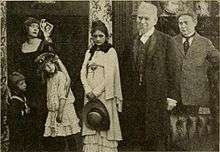Should a Woman Divorce?
Should a Woman Divorce? is a 1914 silent film written by Ivan Abramson and directed by Edwin McKim, and starring Lea Leland and Leonid Samoloff.
| Should a Woman Divorce? | |
|---|---|
 Scene from Should a Woman Divorce? | |
| Directed by | Edwin McKim |
| Produced by | Ivan Film Productions |
| Written by | Ivan Abramson |
| Starring | Lea Leland and Leonid Samoloff |
Release date | 1914 |
| Country | United States |
| Language | Silent film English intertitles |
Plot
Grace Roberts (played by Lea Leland), marries rancher Edward Smith, who is revealed to be a neglectful, vice-ridden spouse. They have a daughter, Vivian. Dr. Franklin (Leonid Samoloff) whisks Grace away from this unhappy life, and they move to New York under aliases, pretending to be married (since surely Smith would not agree to a divorce). Grace and Franklin have a son, Walter (Milton S. Gould). Vivian gets sick, however, and Grace and Franklin return to save her. Somehow this reunion, as Smith had assumed Grace to be dead, causes the death of Franklin. This plot device frees Grace to return to her father's farm with both children.[1]
Cast
- Leonid Samoloff as Dr. Franklin
- Lea Leland as Grace Roberts
- Anna Lehr
- Mabel Wright
- Ordean Stark as Vivian
- Robert Taber
- Frederic Roberts
- Milton S. Gould as Walter (child actor, grandson of Abramson, later became a prominent attorney)
Background and reception
The film was not favorably reviewed by critics, as Robert B. Connelly's 1998 volume on silent films succinctly describes it as a "stinker."[1] Variety noted that "it needed five parts (reels) to unwind this Immoral and Impossible story, and still it didn't answer "Should a Woman Divorce?"[2] Hanford C. Judson of Moving Picture World described the film as "crammed full of humanity, but has no social propaganda at all. It is simply a story that Ivan Abramson has made up, using what license he needed, such as total disregard of American divorce laws, to make his picture entertaining." Judson also noted the picture's "distinct Semitic atmosphere" despite its supposed farming area setting, which is an astute observation as Jewish writer/producer Ivan Abramson had emigrated from Russia and this was one of his first films. Actor Leonid Samoloff was an accomplished tenor who had also emigrated from Russia.[3][4][5]
The film was directed by Edwin McKim, husband of actress Anna Lehr, who are perhaps best known as the parents of actress Ann Dvorak. Some sources list "Edward McKim" as the director of the film, but that appears to be an error.[6]
Abramson's grandson Milton S. Gould was cast in the role of Grace's son Walter.[7]
References
- Connelly, Robert B. The silents: silent feature films, 1910-36, Volume 40, Issue 2, p. 253 (1998)
- Variety Film Reviews, 1907-1980: 1907-1920 (1983) ("SHOULD A WOMAN DIVORCE? It all depends. ... It needed five parts to unwind this Immoral and Impossible story, and still it didn't answer "Should a Woman Divorce? One or two of the principals seemed capable of giving a good performance If they bad the opportunity. One was the young girl friend of the wife. A couple of rural bumpkins were quite painful in their comedy efforts, and "Should a Woman Divorce?" may be said to be bad enough to be classed with the foreign feature films. They could place this film in the same Packard car and use ......")
- Judson, Hanford C. (14 December 1914). "Should a Woman Divorce", Moving Picture World
- (23 April 1915). "Should a Woman Divorce" Feature Film at Berkeley, Berkeley Daily Gazette (review appears to be adapted from the Moving Picture World review)
- Leonid Samoloff and Assisting Artists, The Lyceum Magazine (March 1917, p. 57)
- Should A Woman Divorce?, American Film Institute website, Retrieved October 18, 2011
- Pizzitola, Louis. Hearst over Hollywood, p. 133 (2002)